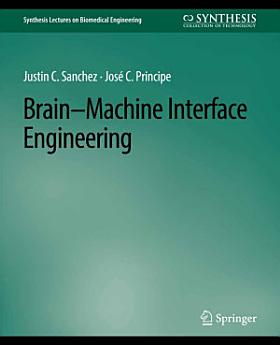Brain-Machine Interface Engineering
Juni 2022 · Springer Nature
E-Book
234
Seiten
reportBewertungen und Rezensionen werden nicht geprüft Weitere Informationen
Über dieses E-Book
Neural interfaces are one of the most exciting emerging technologies to impact bioengineering and neuroscience because they enable an alternate communication channel linking directly the nervous system with man-made devices. This book reveals the essential engineering principles and signal processing tools for deriving control commands from bioelectric signals in large ensembles of neurons. The topics featured include analysis techniques for determining neural representation, modeling in motor systems, computing with neural spikes, and hardware implementation of neural interfaces. Beginning with an exploration of the historical developments that have led to the decoding of information from neural interfaces, this book compares the theory and performance of new neural engineering approaches for BMIs. Contents: Introduction to Neural Interfaces / Foundations of Neuronal Representations / Input-Outpur BMI Models / Regularization Techniques for BMI Models / Neural Decoding Using GenerativeBMI Models / Adaptive Algorithms for Point Processes / BMI Systems
Autoren-Profil
Dr. Sanchez’s research interests are in Neural Engineering and neural assistive technologies. Topics include the analysis of neural ensemble recordings, adaptive signal processing, Brain-Machine Interfaces, motor system electrophysiology, treatment of movement disorders, and the neurophysiology of epilepsy. He is an Assistant Pro[1]fessor of Pediatrics, Neuroscience, and Biomedical Engineering at the University of Florida College of Medicine, Engineering, and McKnight Brain Institute in Gainesville, Florida. He received his Ph.D. (2004) and M.E. degrees in Biomedical Engineering and B.S. degree in Engineering Science (Highest Honors—2000) with a minor in Biomechanics from the University of Florida. The goal of his research is to develop state-of-the-art novel medical treatments by operating at the interface between basic neural engineering research and clinical care. This direction of research is motivated by the potential of direct neural interfaces for delivering therapy and restoring functionality to disabled individuals using engineering principles. In 2005, he won two prestigious awards for his work including Excellence in Neuroengineering and more recently an American Epilepsy Society Young Investigator Award. In 2006 he founded the Gainesville Engineering in Medicine and Biology/Communications Joint Societies Chapter and serves as the IEEE Gainesville Section Director for membership development. His neural engineering electrophysiology laboratory is currently developing direct neural interfaces for use in the research and clinical settings and has published over 35 peer review papers and holds 3 patents in neuroprosthetic design. He is the founding member of the Neuroprosthetics Group (NRG) at the University of Florida (http://nrg.mbi.ufl.edu).
Dieses E-Book bewerten
Deine Meinung ist gefragt!
Informationen zum Lesen
Smartphones und Tablets
Nachdem du die Google Play Bücher App für Android und iPad/iPhone installiert hast, wird diese automatisch mit deinem Konto synchronisiert, sodass du auch unterwegs online und offline lesen kannst.
Laptops und Computer
Im Webbrowser auf deinem Computer kannst du dir Hörbucher anhören, die du bei Google Play gekauft hast.
E-Reader und andere Geräte
Wenn du Bücher auf E-Ink-Geräten lesen möchtest, beispielsweise auf einem Kobo eReader, lade eine Datei herunter und übertrage sie auf dein Gerät. Eine ausführliche Anleitung zum Übertragen der Dateien auf unterstützte E-Reader findest du in der Hilfe.




